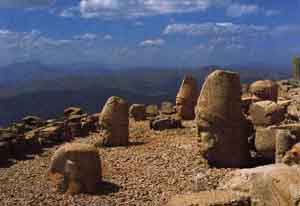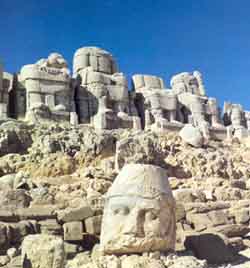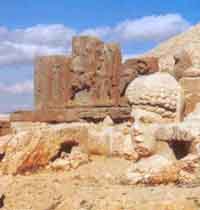

 Nemrut Dag (Mt Nemrud) is a mountain measuring
2,150meters in height. It is located near the village of Karadut in Kahta
county in the province of Adiyaman.
Kings of the Kommagene dynasty from 80 B.C. to 72 A.D ruled
Adiyaman and
its vicinity. This kingdom,
whose capital was Samosata (now called Samsat), was founded around 80 B.C.
by Mithridates 1, father of Antiochos 1. The kingdom's independence came
to an end with its defeat by Roman legions in the last of the Kommagene
wars and it became part of the Roman province of Syria. At its height,
Kommagene extended from the Toros (Taurus) mountains on the north to the
Firat (Euphrates) river on the east and southeast, to present-day
Gaziantep on the south, and to the county of Pazarcik in Kahramanmaras on
the west.The magnificent ruins on the summit of Mt Nemrud are not those of
an inhabited site however. They are instead the famous tumulus (burial
mound) and hierotheseion (a word that is derived from Greek and refers to
the sacred burial precinct of
Nemrut Dag (Mt Nemrud) is a mountain measuring
2,150meters in height. It is located near the village of Karadut in Kahta
county in the province of Adiyaman.
Kings of the Kommagene dynasty from 80 B.C. to 72 A.D ruled
Adiyaman and
its vicinity. This kingdom,
whose capital was Samosata (now called Samsat), was founded around 80 B.C.
by Mithridates 1, father of Antiochos 1. The kingdom's independence came
to an end with its defeat by Roman legions in the last of the Kommagene
wars and it became part of the Roman province of Syria. At its height,
Kommagene extended from the Toros (Taurus) mountains on the north to the
Firat (Euphrates) river on the east and southeast, to present-day
Gaziantep on the south, and to the county of Pazarcik in Kahramanmaras on
the west.The magnificent ruins on the summit of Mt Nemrud are not those of
an inhabited site however. They are instead the famous tumulus (burial
mound) and hierotheseion (a word that is derived from Greek and refers to
the sacred burial precinct of the royal family, and whose use is known
only in Kommagene) of King Antiochos I of Kommagene, who ruled from 69 to
36 B.C. In a cult inscription, King Antiochos declares that he had the
site built for the ages and generations that were to follow him "as a
debt of thanks to the gods and to his deified ancestors for their manifest
assistance". The king also declares that his aim was to provide for
the people an "ex- ample of the piety that the gods commanded be
shown towards the gods and towards ancestors. "Professor
K. Dorner has traced the genealogy of Antiochos 1, who was himself born of
a Persian father and a Seleucid-Macedonian mother. His findings indicate
that Antiochos I of Commagene claimed descent, through his father
Mithridates, from Dareios (Darius) 1 (522-486 B.C.) and, through his
mother Laodike, from Alexander the Great (356-323 B.C.)
Mt Nemrud is located 100 kms from Adiyaman. No reference is made to
it in ancient sources. Karl Sester, a German road engineer, rediscovered
it in modern times in 1881. An expedition to Mt Nemrud was organized in
the royal family, and whose use is known
only in Kommagene) of King Antiochos I of Kommagene, who ruled from 69 to
36 B.C. In a cult inscription, King Antiochos declares that he had the
site built for the ages and generations that were to follow him "as a
debt of thanks to the gods and to his deified ancestors for their manifest
assistance". The king also declares that his aim was to provide for
the people an "ex- ample of the piety that the gods commanded be
shown towards the gods and towards ancestors. "Professor
K. Dorner has traced the genealogy of Antiochos 1, who was himself born of
a Persian father and a Seleucid-Macedonian mother. His findings indicate
that Antiochos I of Commagene claimed descent, through his father
Mithridates, from Dareios (Darius) 1 (522-486 B.C.) and, through his
mother Laodike, from Alexander the Great (356-323 B.C.)
Mt Nemrud is located 100 kms from Adiyaman. No reference is made to
it in ancient sources. Karl Sester, a German road engineer, rediscovered
it in modern times in 1881. An expedition to Mt Nemrud was organized in
 1882-83 by Karl Humann and Otto Puchstein, who published their findings in
a book entitled Reisen in Kleinasien und Nordsyrien (Berlin 1890). Osman
Hamdi Bey and Osgan Effendi also investigated the site in 1883 and their
findings were published in a book entitled Le Tumulus de Nemroud Dagh
(Istanbul 1883). F. Karl Dorner and Rudolf Naumann mounted an expedition
to Mt Nemrud in 1938. Dorner returned to the site after 1951 and began
working there with the US researcher Teresa
Goell. In 1984, a
Turkish-German team led by Professor Dorner successfully carried out
restoration work at the site. Excavation and restoration
work has been continuing since 1989 under the direction of Sencer Sahin.
In 1989, Nemrut Dag and its environs were declared a national park.
The tumulus on the summit of Mt Nemrud measures 50 meters high and
covers an area 150 meters in diameter. It is formed from stones the size
of a fist and is bounded on the east, west, and north by terraced courts
carved out of the native rock. The eastern court was the center of the
sacred precinct and is the most important group of sculptural and
architectural works. It is surrounded on the west by colossal statues, on
the east by a fire altar in the shape of a stepped pyramid, and on the
north and south by low walls of orthostats (upright stone slabs) standing
on a long, narrow base.
1882-83 by Karl Humann and Otto Puchstein, who published their findings in
a book entitled Reisen in Kleinasien und Nordsyrien (Berlin 1890). Osman
Hamdi Bey and Osgan Effendi also investigated the site in 1883 and their
findings were published in a book entitled Le Tumulus de Nemroud Dagh
(Istanbul 1883). F. Karl Dorner and Rudolf Naumann mounted an expedition
to Mt Nemrud in 1938. Dorner returned to the site after 1951 and began
working there with the US researcher Teresa
Goell. In 1984, a
Turkish-German team led by Professor Dorner successfully carried out
restoration work at the site. Excavation and restoration
work has been continuing since 1989 under the direction of Sencer Sahin.
In 1989, Nemrut Dag and its environs were declared a national park.
The tumulus on the summit of Mt Nemrud measures 50 meters high and
covers an area 150 meters in diameter. It is formed from stones the size
of a fist and is bounded on the east, west, and north by terraced courts
carved out of the native rock. The eastern court was the center of the
sacred precinct and is the most important group of sculptural and
architectural works. It is surrounded on the west by colossal statues, on
the east by a fire altar in the shape of a stepped pyramid, and on the
north and south by low walls of orthostats (upright stone slabs) standing
on a long, narrow base.
The orthostats overlooking the court on the north
were deco- rated with reliefs depicting the Persian ancestors of Antiochos
while those on the south had reliefs depicting his Macedonian forbears. At
the head of the list of deified ancestors there are two eminent names: that of Dareios 1, the founder of the Achaemenid dynasty on his father's
side, and of Alexander the Great on his mother's. The names of the persons
depicted in the reliefs on the fronts of the orthostats were carved on the
rear faces. In front of each relief there was an altar on which sacrifices
could be performed.The well-preserved colossal statues overlooking the
court on the east are made of blocks of limestone and measure eight to ten
meters in height. The figures are shown in a sitting position.
Inscriptions identify the statues (whose names are given
in Greek and Persian on account of the syncretic amalgamation of the Greek
and Persian religions) on the eastern terrace from left to right in the
following order: Antiochos, the goddess Kommagene, Zeus-Oromasdes (the
Graeco-Persian sky-god and supreme deity, and also the largest-sized
statue), Apollo-Mithras, and Herakles-Artagnes. On either side of the
divinities stood a guardian eagle and lion. The heads of all the deities
have toppled over onto ground in the intervening centuries. Their finely
worked facial features are striking examples of the idealized late
Hellenistic style. The gods wear Persian headgear. The necks of Antiochos
and the other gods are protected by lappets in the Persian fashion. The
head of the goddess Kommagene is decorated with a crown of fruit. The
sides of the pedestals overlooking the court and the tumulus are inscribed
with the country's laws and commandments as
that of Dareios 1, the founder of the Achaemenid dynasty on his father's
side, and of Alexander the Great on his mother's. The names of the persons
depicted in the reliefs on the fronts of the orthostats were carved on the
rear faces. In front of each relief there was an altar on which sacrifices
could be performed.The well-preserved colossal statues overlooking the
court on the east are made of blocks of limestone and measure eight to ten
meters in height. The figures are shown in a sitting position.
Inscriptions identify the statues (whose names are given
in Greek and Persian on account of the syncretic amalgamation of the Greek
and Persian religions) on the eastern terrace from left to right in the
following order: Antiochos, the goddess Kommagene, Zeus-Oromasdes (the
Graeco-Persian sky-god and supreme deity, and also the largest-sized
statue), Apollo-Mithras, and Herakles-Artagnes. On either side of the
divinities stood a guardian eagle and lion. The heads of all the deities
have toppled over onto ground in the intervening centuries. Their finely
worked facial features are striking examples of the idealized late
Hellenistic style. The gods wear Persian headgear. The necks of Antiochos
and the other gods are protected by lappets in the Persian fashion. The
head of the goddess Kommagene is decorated with a crown of fruit. The
sides of the pedestals overlooking the court and the tumulus are inscribed
with the country's laws and commandments as
 well as with the king's
birthday and de- tails of cult procedures, all written in the Greek
script. The colossal statues
on the western terrace are arranged in the same way as those on the east.
Their heads also lie about on the ground but are better preserved. The
statues were re-erected in their places in the course of work carried out
in 1985 under the direction of F. K. D6rner. Owing to the different
topographical features between the east and west terraces, the orthostats
bearing the inscriptions and reliefs of the ancestors on the latter are
arranged differently
from those on the former.
well as with the king's
birthday and de- tails of cult procedures, all written in the Greek
script. The colossal statues
on the western terrace are arranged in the same way as those on the east.
Their heads also lie about on the ground but are better preserved. The
statues were re-erected in their places in the course of work carried out
in 1985 under the direction of F. K. D6rner. Owing to the different
topographical features between the east and west terraces, the orthostats
bearing the inscriptions and reliefs of the ancestors on the latter are
arranged differently
from those on the former.
The slabs with the reliefs of the king's Persian
ancestors are set along the southern edge of the western terrace while
those of his Macedonian forbears are arranged opposite the monumental
statues. In the western terrace, the reliefs showing Antiochos shaking
hands with different divinities are very well preserved; of the slabs that
depicted the same scenes on the east terrace, only a few fragments remain.
The handshaking scenes that are to be seen on the west are as follows:
Antiochos and the goddess Kommagene; Antiochos and Apollo-Mithras;
Antiochos and Zeus-Oromasdes; Antiochos and Herakles-Artagnes. The relief of the lion in the west court is of
particular interest. The stone slab measures 1.75 meters in height and is
2.40 meters long. It shows a powerful lion walking to the right. Its body
is decorated with nineteen stars and there is a crescent moon on the
breast. From the three larger stars on the lion's back, sixteen rays
emerge as opposed to the smaller stars, which have
only eight rays each. These three larger stars are identified in writing
as Jupiter, Mercury, and Mars. What we see here is a picture of the
world's oldest horoscope. It was originally supposed that the horoscope
referred to Antiochoss birthdate but Professor Otto Neugebauer
identifies it as the seventh of July in the year 62 or 61 B.C. This
corresponds to the date on which Antiochos I was installed on the throne
by the Roman general Pompey. According to Professor Dorner on the other
hand, the event being represented is the establishment of the Nemrut Dag,
monument. The north terrace
took the form of a processional way that connected the terraces on the
east and west. The colossal statues of an eagle on either side guard the
entrance through the exact center of the wall forming the north terrace.
According to inscriptions on the backs of the thrones on which the
divinities are seated, King Antiochos 1 of Kommagene ordered that he be
buried in this hierothseion. The excavations that have been carried out
here have revealed that the tumulus was heaped up atop rocky hill. This
makes it very likely that the king's bones (or ashes) were placed in a
chamber cut into the rock an that the chamber was then covered over with
the tumulus. Despite efforts however, the burial chamber itself has not
yet been reached.
decorated with nineteen stars and there is a crescent moon on the
breast. From the three larger stars on the lion's back, sixteen rays
emerge as opposed to the smaller stars, which have
only eight rays each. These three larger stars are identified in writing
as Jupiter, Mercury, and Mars. What we see here is a picture of the
world's oldest horoscope. It was originally supposed that the horoscope
referred to Antiochoss birthdate but Professor Otto Neugebauer
identifies it as the seventh of July in the year 62 or 61 B.C. This
corresponds to the date on which Antiochos I was installed on the throne
by the Roman general Pompey. According to Professor Dorner on the other
hand, the event being represented is the establishment of the Nemrut Dag,
monument. The north terrace
took the form of a processional way that connected the terraces on the
east and west. The colossal statues of an eagle on either side guard the
entrance through the exact center of the wall forming the north terrace.
According to inscriptions on the backs of the thrones on which the
divinities are seated, King Antiochos 1 of Kommagene ordered that he be
buried in this hierothseion. The excavations that have been carried out
here have revealed that the tumulus was heaped up atop rocky hill. This
makes it very likely that the king's bones (or ashes) were placed in a
chamber cut into the rock an that the chamber was then covered over with
the tumulus. Despite efforts however, the burial chamber itself has not
yet been reached.
| Türkçe | Page 1 | Page 2 | Page 3 |
How to go to Mt. Nemrut (Click)
![]()
Home | All About Turkey
| Turkish Road Map
| Historical Places in Adiyaman | Historical
Places in Turkey | Mt.Nemrut | Slide
Shows | Related Links | Guest
Book | Disclaimer | Donate a little to help | Getting Around Istanbul | Adiyaman Forum |
Ana Sayfa | Türkiye hakkindaki Hersey | Türkiye Yol Haritasi | Adiyamandaki Tarihi Yerler | Türkiyedeki Tarihi Yerler | Nemrut Tepesi | Dia Gösterisi | Önemli Linkler | Konuk Defteri | Açiklama
|
|